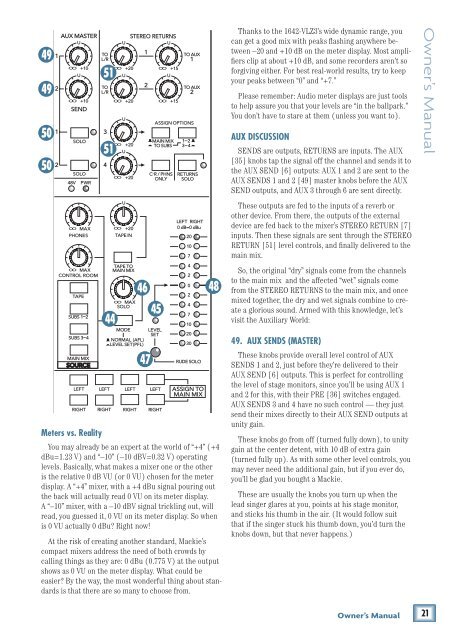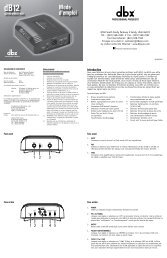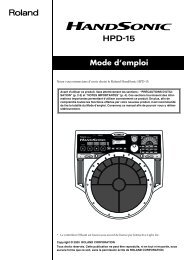1642-VLZ3 16-Channel Mic/Line Mixer Owner's Manual
1642-VLZ3 16-Channel Mic/Line Mixer Owner's Manual
1642-VLZ3 16-Channel Mic/Line Mixer Owner's Manual
Create successful ePaper yourself
Turn your PDF publications into a flip-book with our unique Google optimized e-Paper software.
49<br />
49<br />
50<br />
50<br />
51<br />
51<br />
Thanks to the <strong><strong>16</strong>42</strong>-<strong>VLZ3</strong>’s wide dynamic range, you<br />
can get a good mix with peaks flashing anywhere between<br />
–20 and +10 dB on the meter display. Most amplifiers<br />
clip at about +10 dB, and some recorders aren’t so<br />
forgiving either. For best real-world results, try to keep<br />
your peaks between “0” and “+7.”<br />
Please remember: Audio meter displays are just tools<br />
to help assure you that your levels are “in the ballpark.”<br />
You don’t have to stare at them (unless you want to).<br />
AUX DISCUSSION<br />
SENDS are outputs, RETURNS are inputs. The AUX<br />
[35] knobs tap the signal off the channel and sends it to<br />
the AUX SEND [6] outputs: AUX 1 and 2 are sent to the<br />
AUX SENDS 1 and 2 [49] master knobs before the AUX<br />
SEND outputs, and AUX 3 through 6 are sent directly.<br />
Owner’s <strong>Manual</strong><br />
These outputs are fed to the inputs of a reverb or<br />
other device. From there, the outputs of the external<br />
device are fed back to the mixer’s STEREO RETURN [7]<br />
inputs. Then these signals are sent through the STEREO<br />
RETURN [51] level controls, and finally delivered to the<br />
main mix.<br />
44<br />
46<br />
45<br />
48<br />
So, the original “dry” signals come from the channels<br />
to the main mix and the affected “wet” signals come<br />
from the STEREO RETURNS to the main mix, and once<br />
mixed together, the dry and wet signals combine to create<br />
a glorious sound. Armed with this knowledge, let’s<br />
visit the Auxiliary World:<br />
Meters vs. Reality<br />
47<br />
You may already be an expert at the world of “+4” (+4<br />
dBu=1.23 V) and “–10” (–10 dBV=0.32 V) operating<br />
levels. Basically, what makes a mixer one or the other<br />
is the relative 0 dB VU (or 0 VU) chosen for the meter<br />
display. A “+4” mixer, with a +4 dBu signal pouring out<br />
the back will actually read 0 VU on its meter display.<br />
A “–10” mixer, with a –10 dBV signal trickling out, will<br />
read, you guessed it, 0 VU on its meter display. So when<br />
is 0 VU actually 0 dBu Right now!<br />
At the risk of creating another standard, Mackie’s<br />
compact mixers address the need of both crowds by<br />
calling things as they are: 0 dBu (0.775 V) at the output<br />
shows as 0 VU on the meter display. What could be<br />
easier By the way, the most wonderful thing about standards<br />
is that there are so many to choose from.<br />
49. AUX SENDS (MASTER)<br />
These knobs provide overall level control of AUX<br />
SENDS 1 and 2, just before they’re delivered to their<br />
AUX SEND [6] outputs. This is perfect for controlling<br />
the level of stage monitors, since you’ll be using AUX 1<br />
and 2 for this, with their PRE [36] switches engaged.<br />
AUX SENDS 3 and 4 have no such control — they just<br />
send their mixes directly to their AUX SEND outputs at<br />
unity gain.<br />
These knobs go from off (turned fully down), to unity<br />
gain at the center detent, with 10 dB of extra gain<br />
(turned fully up). As with some other level controls, you<br />
may never need the additional gain, but if you ever do,<br />
you’ll be glad you bought a Mackie.<br />
These are usually the knobs you turn up when the<br />
lead singer glares at you, points at his stage monitor,<br />
and sticks his thumb in the air. (It would follow suit<br />
that if the singer stuck his thumb down, you’d turn the<br />
knobs down, but that never happens.)<br />
Owner’s <strong>Manual</strong><br />
21
















